Strength Characteristics of Iron Tailings Blended Soil as a Road Base Material
Abstract
:1. Introduction
2. Materials and Methods
2.1. Materials
2.2. Test Methods
3. Results and Discussion
3.1. Unconfined Compressive Strength
3.1.1. Influence of Iron Tailing Sand Content
3.1.2. Influence of Cement Content
3.1.3. Influence of Soil Curing Agent Content
3.1.4. Influence of Water Content
3.1.5. Water Stability
3.2. Splitting Strength and Flexural-Tensile Strength
3.3. Mineral Compositions Affected by Additive Agents
3.4. Microstructures Affected by Additive Agents
3.5. Microstructures Affected by Iron Tailing Sand Content
4. Conclusions
- Considering both economy and practical implications, the optimal mix proportion of ITBS is determined as follows, ITS:soil = 50%:50%, and then mixed with 5% cement and 2% soil curing agent in total weight of ITS and soil.
- Under the optimum mix proportion conditions, the compressive strength of ITBS can be effectively exerted when the water content is about 12%. The samples of standard curing and soaking curing increase gradually with the increase of age, and the samples under the condition of long-term soaking curing still have high strength assurance rate, and the ITBS has good water stability.
- The splitting strength and flexural tensile strength of the mixture also increase with the increase of age and increase first and then decrease with the increase of the sand to soil ratio.
- The XRD and SEM results show that the addition of curing agent yielded almost no new substances but the ion exchange reaction between curing agent and soil could occur, which made the aggregate more compact. C-S-H gel and CaCO3 were produced in the mixed soil due to hydration of cement. These substances filled the pores of aggregate and made the bond between ITS and soil particles more compact and the strength further increased. Using the curing agent in conjunction with the cement can generate a higher strength. In addition, when the contents of the soil and ITS are equal, the combination between the two components is getting closer.
Author Contributions
Funding
Institutional Review Board Statement
Informed Consent Statement
Data Availability Statement
Conflicts of Interest
References
- Yu, F.; Cao, Y.; Fang, Y.; Zhang, Y.; Niu, K. Mechanical behavior of self-stressing steel slag aggregate concrete filled steel tubular short columns with different loading modes. Structures 2020, 26, 947–957. [Google Scholar] [CrossRef]
- Bing, L.; Zhongying, Z.; Biao, T.; Hongbo, L.; Hanchi, C.; Zhen, M. Comprehensive Utilization of Iron Tailings in China; IOP Publishing: Bristol, UK, 2018; Volume 199. [Google Scholar]
- Wang, K.; Liu, Y.; Lyu, G.; Li, X.; Chen, X. A review of comprehensive utilization of high-iron red mud of China. Light Met. 2020, 65–71. [Google Scholar] [CrossRef]
- Filho, J.N.S.A.; Da Silva, S.N.; Silva, G.C.; Mendes, J.C.; Peixoto, R.A.F. Technical and environmental feasibility of interlocking concrete pavers with iron ore tailings from tailings dams. J. Mater. Civil Eng. 2017, 29, 04017104. [Google Scholar] [CrossRef]
- Lv, X.; Shen, W.; Wang, L.; Dong, Y.; Zhang, J.; Xie, Z. A comparative study on the practical utilization of iron tailings as a complete replacement of normal aggregates in dam concrete with different gradation. J. Clean. Prod. 2019, 211, 704–715. [Google Scholar] [CrossRef]
- Flórez, C.; Neumann, R.; Espósito, T.; Barbosa, M.C. Response of granular iron tailings to laboratory-induced environmental stressing. Environ. Geotech. 2020, 40, 1–11. [Google Scholar] [CrossRef]
- Franks, D.M.; Stringer, M.; Torres-Cruz, L.A.; Baker, E.; Valenta, R.; Thygesen, K.; Barrie, S. Tailings facility disclosures reveal stability risks. Sci. Rep. 2021, 11, 1–7. [Google Scholar]
- Xu, S. Research on application of iron tailings on road base. Adv. Mater. Res. 2013, 743, 54–57. [Google Scholar] [CrossRef]
- Zhang, X.; Yang, H.; Cui, Z. Evaluation and analysis of soil migration and distribution characteristics of heavy metals in iron tailings. J. Clean. Prod. 2018, 172, 475–480. [Google Scholar] [CrossRef]
- Manjarrez, L.; Zhang, L. Utilization of copper mine tailings as road base construction material through geopolymerization. J. Mater. Civil Eng. 2018, 30, 04018201. [Google Scholar] [CrossRef]
- Babatunde, A.Q.; Oshioname, E.A.; Paul, Y.; Junwolo, O.K. Effect of elapsed time after mixing on the strength properties of lime–iron ore tailings treated black cotton soil as a road construction material. Infrastructures 2020, 5, 89. [Google Scholar] [CrossRef]
- Barati, S.; Tabatabaie Shourijeh, P.; Samani, N.; Asadi, S. Stabilization of iron ore tailings with cement and bentonite: A case study on Golgohar mine. Bull. Eng. Geol. Environ. 2020, 79, 4151–4166. [Google Scholar] [CrossRef]
- Manjunatha, L.S.; Sunil, B.M. Stabilization/solidification of iron ore mine tailings using cement, lime and fly ash. Int. J. Res. Eng. 2013, 2, 625–635. [Google Scholar]
- Osinubi, K.J.; Yohanna, P.; Eberemu, A.O. Cement modification of tropical black clay using iron ore tailings as admixture. Transp. Geotech. 2015, 5, 35–49. [Google Scholar] [CrossRef]
- Bastos, L.A.D.C.; Silva, G.C.; Mendes, J.C.; Peixoto, R.A.F. Using iron ore tailings from tailing dams as road material. J. Mater. Civil Eng. 2016, 28, 04016102. [Google Scholar] [CrossRef]
- Ojuri, O.O.; Adavi, A.A.; Oluwatuyi, O.E. Geotechnical and environmental evaluation of lime–cement stabilized soil–mine tailing mixtures for highway construction. Transp. Geotech. 2017, 10, 1–12. [Google Scholar] [CrossRef]
- Ghanizadeh, A.R.; Yarmahmoudi, A.; Abbaslou, H. Mechanical properties of low plasticity clay soil stabilized with iron ore mine tailing and portland cement. J. Min. Env. 2020, 11, 837–853. [Google Scholar]
- Wu, X.T.; Sun, J.S.; Qi, Y.; Chen, B. Pore and compression characteristics of clay solidified by ionic soil stabilizer. Bull. Eng. Geol. Environ. 2021, 80, 5003–5019. [Google Scholar] [CrossRef]
- Wang, X.D.; Li, M.H.; Sha, A.M.; Wang, S.Y.; Zhou, X.Y.; Shen, G.H.; Lu, K.Y. Test Methods of Materials Stabilized with Inorganic Binders for Highway Engineering, JTG E51–2009; China Communication Press: Beijing, China, 2009. [Google Scholar]
- Yao, D.; Qian, G.P.; Yao, J.L.; Liu, J.W.; Yu, X.L. Polymer curing agent in ecological protection design weak rock slope engineering application. J. Perform. Constr. Fac. 2020, 34, 04019115. [Google Scholar] [CrossRef]
- Xiang, G.; Ye, W.; Xu, Y.; Jalal, F.E. Swelling deformation of Na-bentonite in solutions containing different cations. Eng. Geol. 2020, 277, 105757. [Google Scholar] [CrossRef]
- Bahar, R.; Benazzoug, M.; Kenai, S. Performance of compacted cement-stabilised soil. Cem. Concr. comp. 2004, 26, 811–820. [Google Scholar] [CrossRef]
- Sherwood, P. Soil Stabilization with Cement and Lime: State of the Art Review; Her Majesty’s Stationery Office: London, UK, 1993. [Google Scholar]
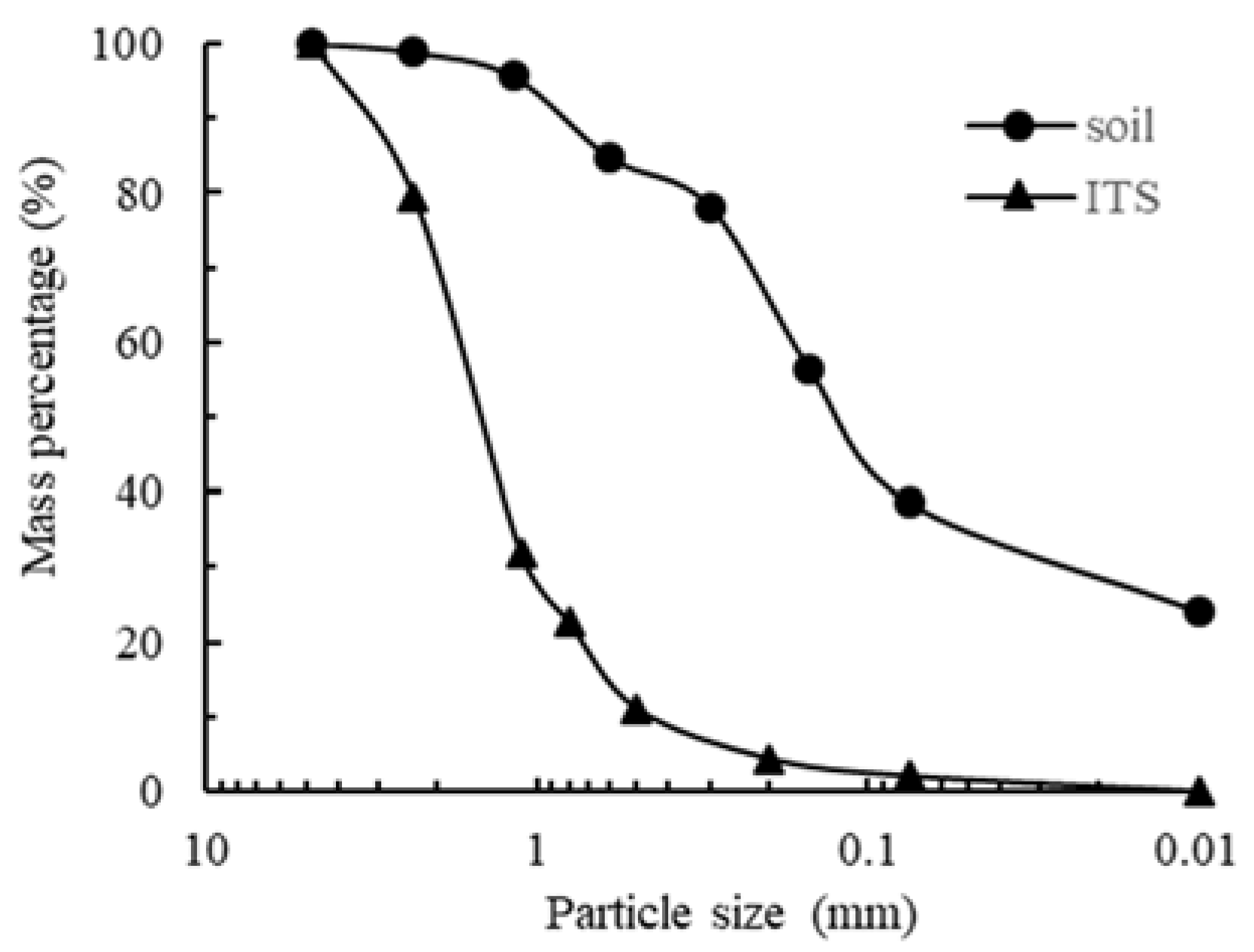

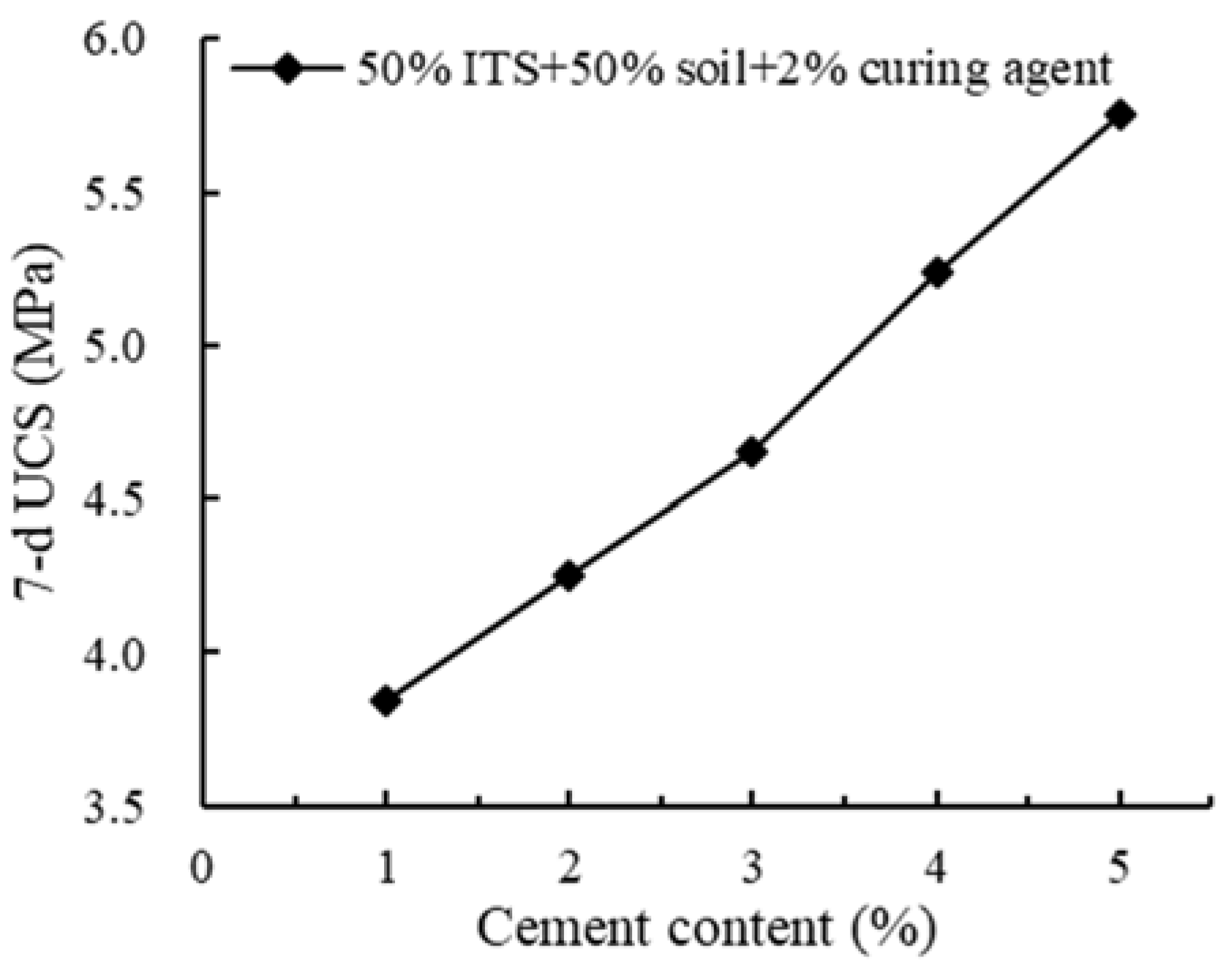
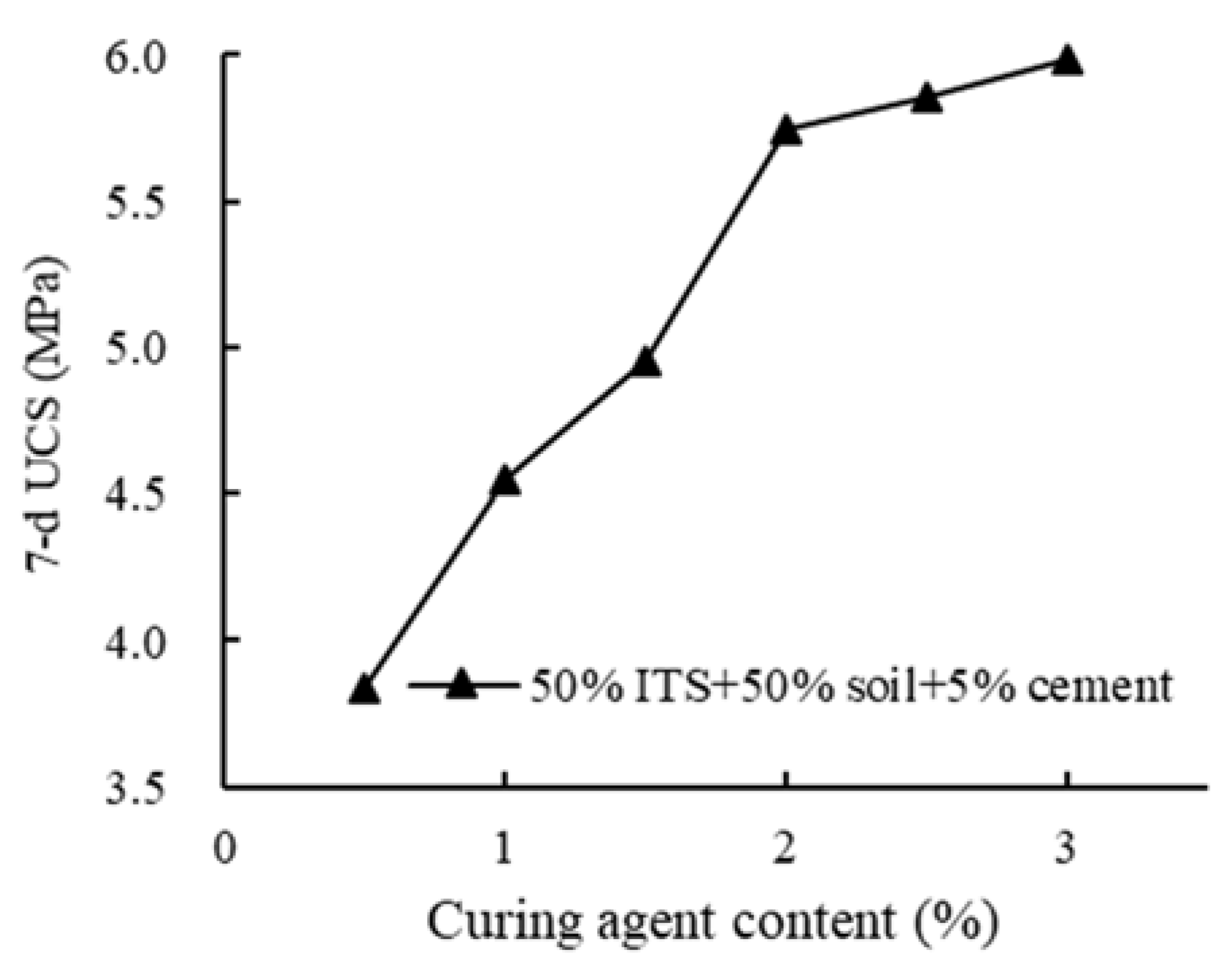
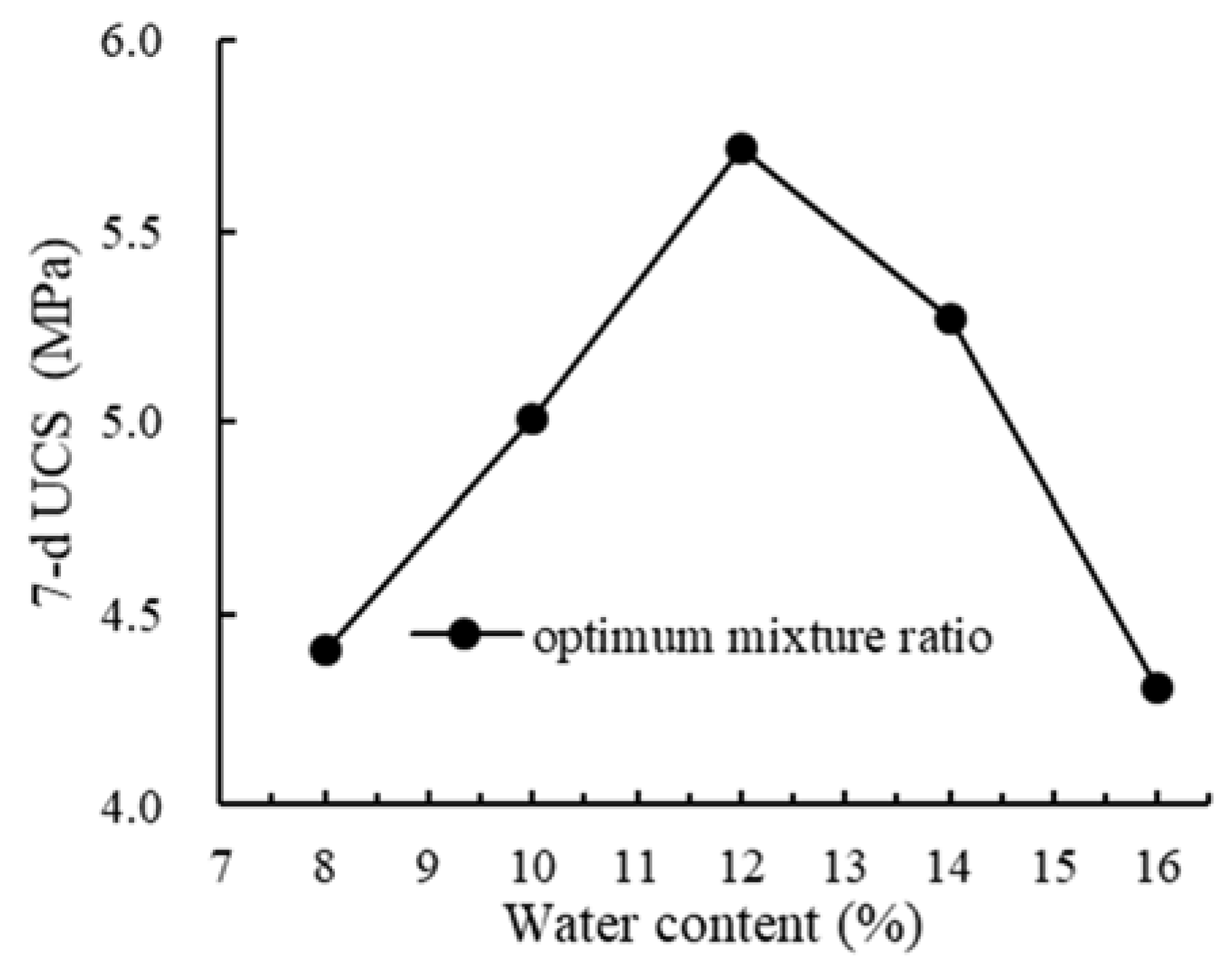
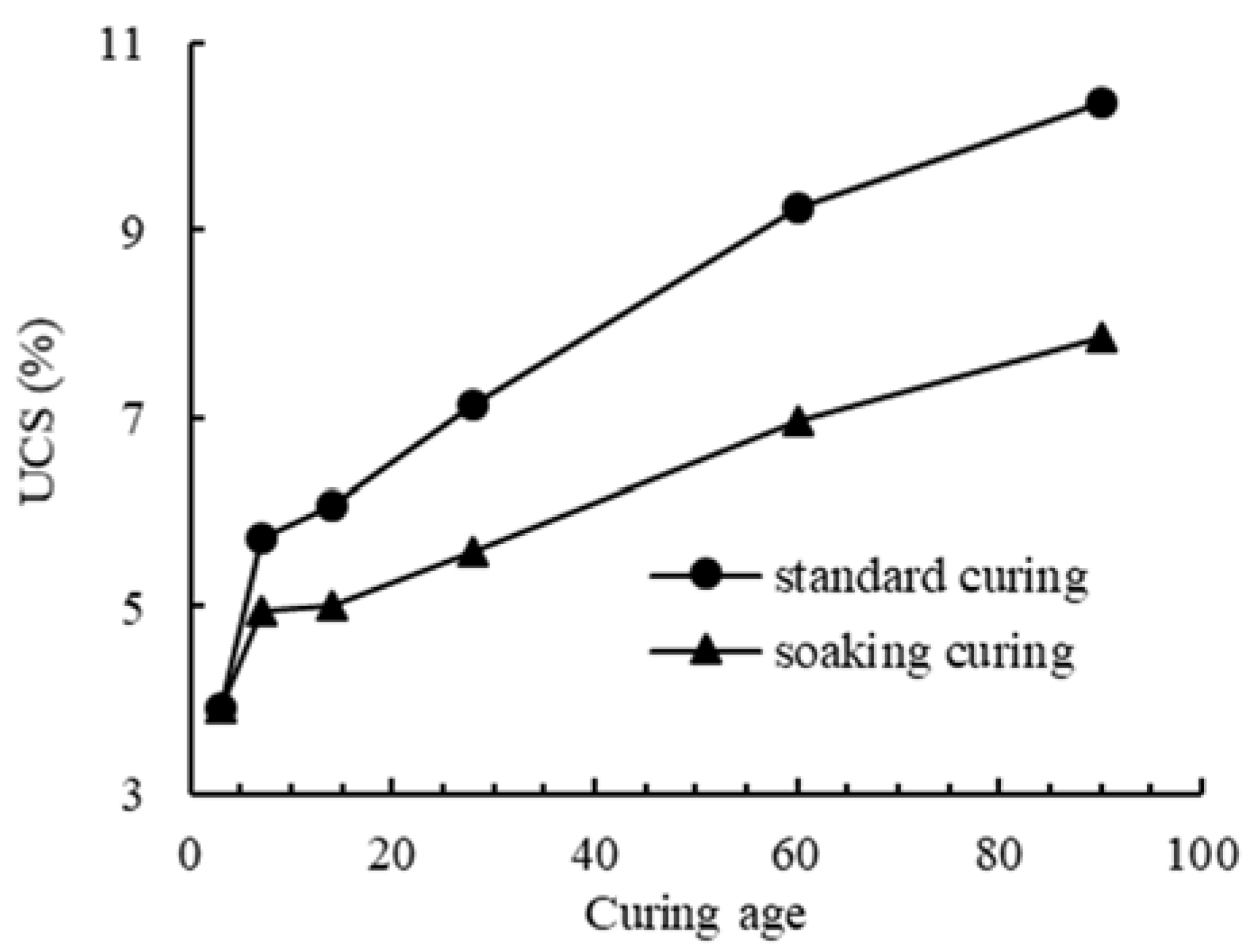

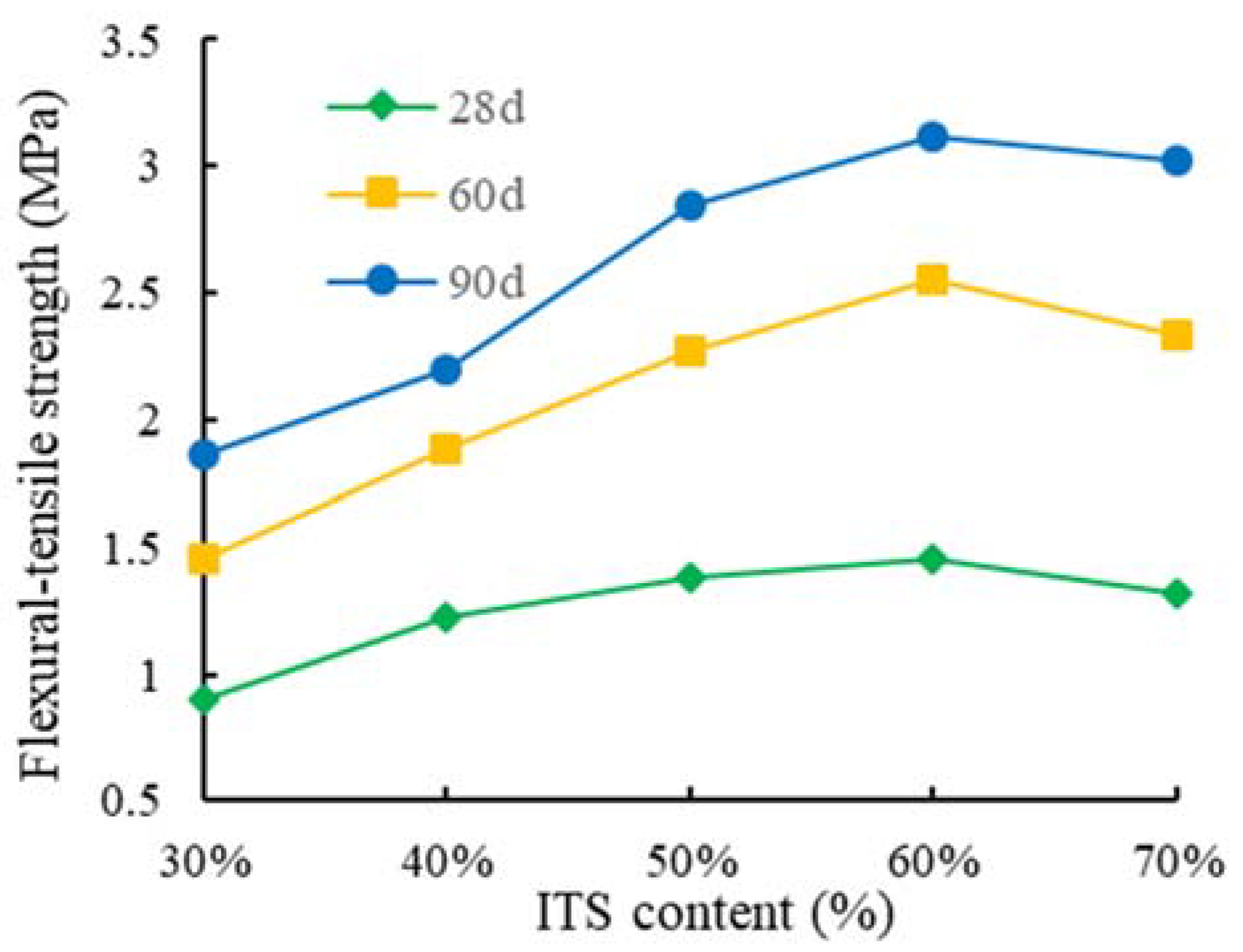
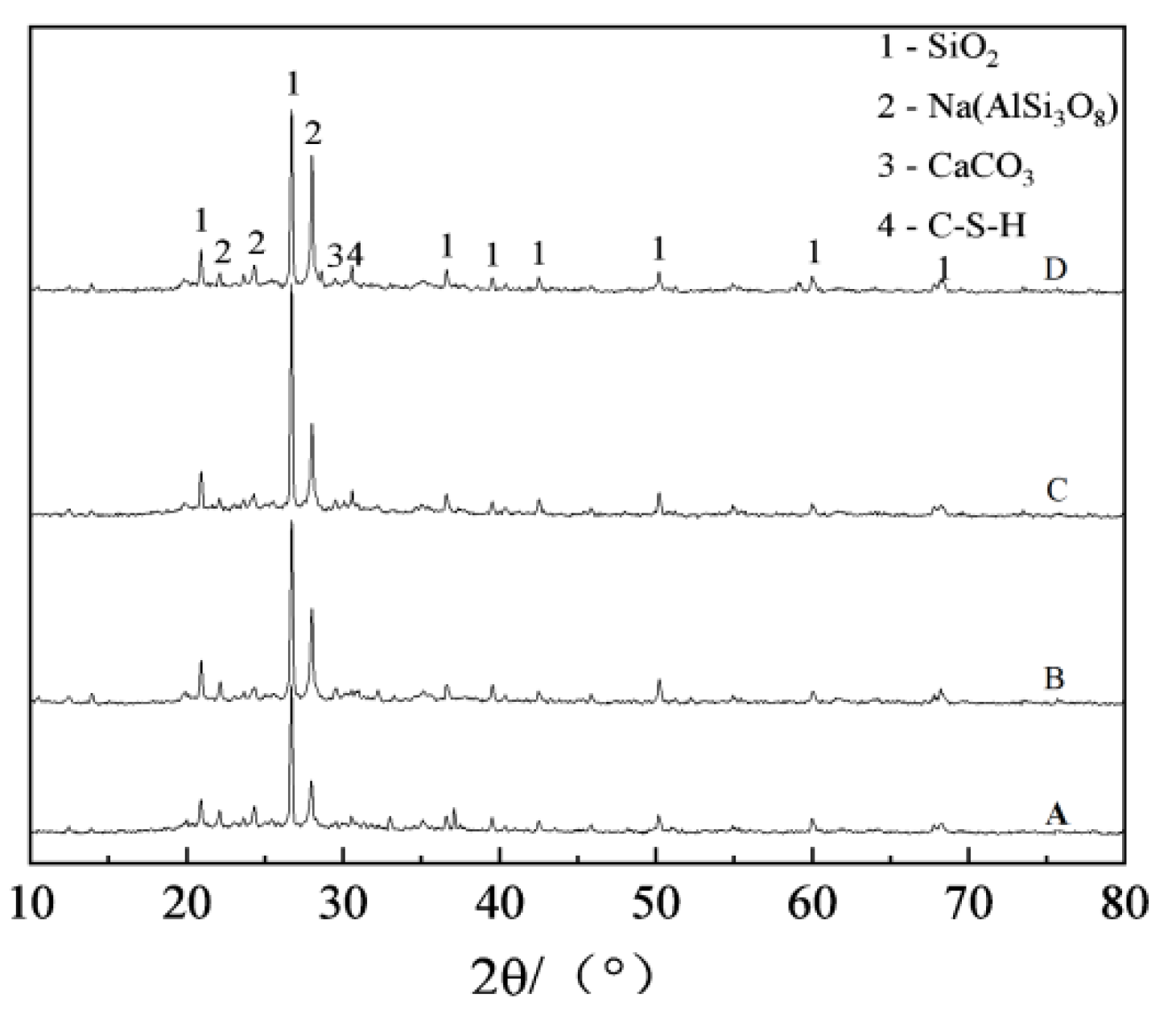

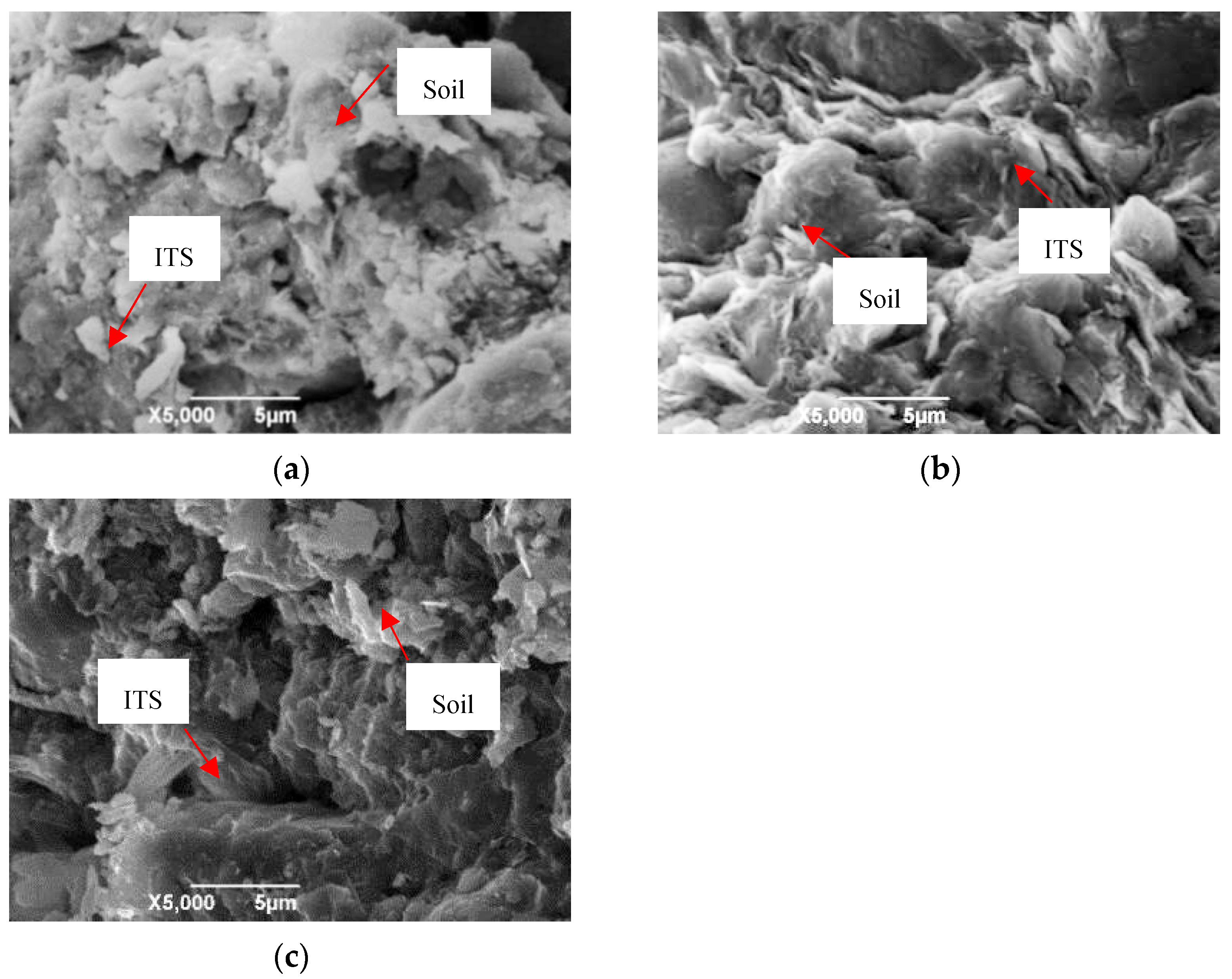
| SiO2 | Fe2O3 | Al2O3 | MgO | CaO | K2O | Na2O | P2O5 | Others |
|---|---|---|---|---|---|---|---|---|
| 70.82 | 13.66 | 5.08 | 4.55 | 3.48 | 0.92 | 0.64 | 0.31 | 0.54 |
| Liquid Limit | Plastic Limit | Plastic Index Ip | Optimum Water Content | Dry Density |
|---|---|---|---|---|
| 39.6% | 20.8% | 18.8 | 14.5% | 1.83 g/cm3 |
| Parameter | Value or Description |
|---|---|
| Component | A by-product of the citrus industry |
| Color | Black, dark amber |
| State | Liquid |
| Density | 1.70 g/cm3 |
| Solubility | Completely soluble in water |
| Odor | Sharp sulfurous smell |
| ITS Content (%) | Cement Content (%) | Curing Agent (%) | Water Content (%) |
|---|---|---|---|
| 30, 40, 50, 60, 70 | 0, 1, 2, 3, 4, 5 | 0, 0.5, 1, 1.5, 2 | 8, 10, 12, 14, 16 |
Publisher’s Note: MDPI stays neutral with regard to jurisdictional claims in published maps and institutional affiliations. |
© 2021 by the authors. Licensee MDPI, Basel, Switzerland. This article is an open access article distributed under the terms and conditions of the Creative Commons Attribution (CC BY) license (https://creativecommons.org/licenses/by/4.0/).
Share and Cite
Tong, J.; Niu, X.; Wang, Y.; Lu, Y. Strength Characteristics of Iron Tailings Blended Soil as a Road Base Material. Appl. Sci. 2021, 11, 7587. https://doi.org/10.3390/app11167587
Tong J, Niu X, Wang Y, Lu Y. Strength Characteristics of Iron Tailings Blended Soil as a Road Base Material. Applied Sciences. 2021; 11(16):7587. https://doi.org/10.3390/app11167587
Chicago/Turabian StyleTong, Jiannan, Xujing Niu, Yonghua Wang, and Yunhua Lu. 2021. "Strength Characteristics of Iron Tailings Blended Soil as a Road Base Material" Applied Sciences 11, no. 16: 7587. https://doi.org/10.3390/app11167587
APA StyleTong, J., Niu, X., Wang, Y., & Lu, Y. (2021). Strength Characteristics of Iron Tailings Blended Soil as a Road Base Material. Applied Sciences, 11(16), 7587. https://doi.org/10.3390/app11167587





